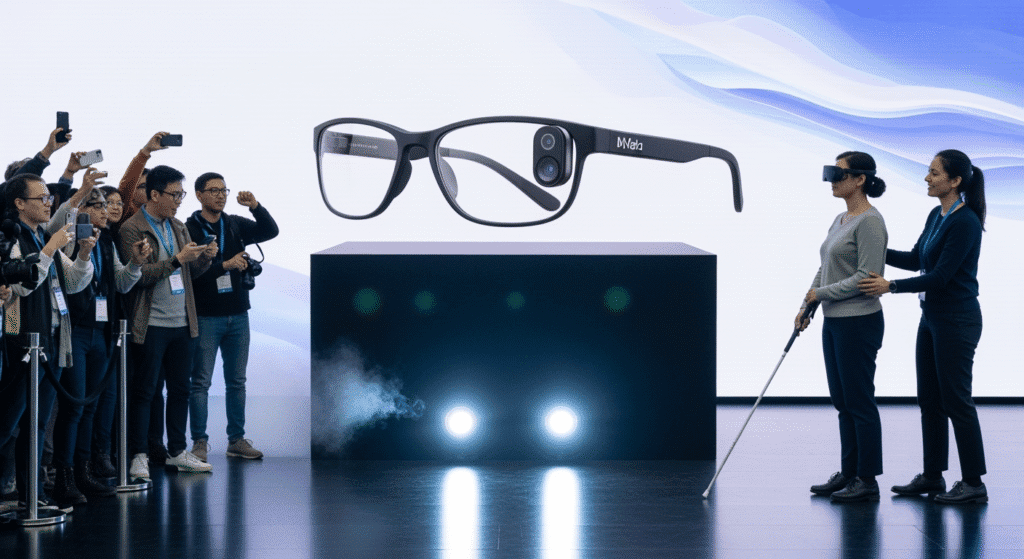
The world of wearable technology took another leap forward last week when Meta unveiled its latest iteration of smart glasses. But while tech enthusiasts debate market viability and privacy concerns, an unexpected community has emerged as the most enthusiastic early adopters: the blind and visually impaired. Their experience reveals both the transformative potential and current limitations of this emerging technology.
Breaking Barriers: How AI Glasses Transform Daily Life
Emeline Lakrout doesn’t let being legally blind stop her from conquering life’s most demanding challenges. The 27-year-old New Yorker has run the grueling NYC Marathon, scaled rock climbing walls, and earned a spot on the U.S. National Paraclimbing Team. Her athletic achievements speak to a determination that refuses to accept limitations. Now, she’s adding Meta’s AI glasses to her carefully curated arsenal of independence tools.
“The glasses make my life easier,” Lakrout explains with the matter-of-fact tone of someone who has learned to adapt and thrive. “They make things faster and they make me able to do more in the day because it’s just quicker and easier to do things and I feel less tired at the end of the day.”
Her experience highlights something Meta’s product development team might not have fully anticipated when designing these devices. While the company originally envisioned mainstream users streaming video content and casually interacting with AI assistants, the blind community discovered transformative applications that go far beyond entertainment or social media integration.
This unexpected adoption pattern reflects a broader trend in technology development. Often, the most meaningful innovations emerge not from intended use cases, but from creative problem-solving by communities with specific needs. The blind community’s embrace of Meta’s smart glasses demonstrates how assistive technology can evolve from mainstream consumer products.
The Technology Behind the Promise
Meta’s newest smart glasses lineup represents a significant technological advancement in wearable computing. The collection includes the Ray-Ban Display glasses, Ray-Ban Meta Gen 2 glasses, and new Oakley models specifically designed for sports enthusiasts. These devices successfully pack impressive computational power and AI capabilities into frames that look remarkably similar to traditional eyewear.
The glasses seamlessly connect with the “Be My Eyes” app, a revolutionary platform that links blind and visually impaired users with sighted volunteers for real-time assistance. This connection creates a powerful bridge between digital AI assistance and human intelligence. Whether users need help sorting through mail, navigating complex grocery store layouts, or understanding visual information in their environment, the combination provides comprehensive support.
Perhaps the most revolutionary feature for the blind community is the optical character recognition (OCR) capability. The glasses can recognize and read aloud text from menus, receipts, mail, street signs, and virtually any printed material. For someone like Lakrout, accessing text-based information in subway stations, on street corners, or in restaurants represents a significant leap toward complete independence.
The integration goes beyond simple text reading. The AI can provide context about surroundings, describe scenes, identify objects, and even recognize people. This comprehensive visual interpretation transforms the glasses into a sophisticated digital guide that operates continuously throughout the day.
Real-World Applications and Current Limitations
Despite impressive capabilities, the technology isn’t perfect. Lakrout discovered these limitations firsthand during a restaurant visit that perfectly illustrated both the promise and current constraints of the system. While the glasses flawlessly read the entire menu aloud, providing detailed descriptions of dishes and ingredients, they stumbled when she asked for specific pricing information on a second prompt.
This inconsistency reveals a fundamental challenge with current AI systems. They excel at certain tasks while failing at others that seem equally straightforward. The unpredictability can be frustrating for users who need reliable, consistent performance for daily navigation.
Battery life presents another significant challenge. During extended use of AI-powered features, the glasses drain quickly, requiring frequent charging breaks that interrupt daily activities. Users must carefully manage power consumption, often keeping the glasses in their charging case between uses. This limitation affects the seamless integration that would make the technology truly transformative.
Mark Riccobono, president of the National Federation of the Blind, offers a balanced perspective that acknowledges both strengths and weaknesses: “They work well for some things, doesn’t work well in other situations.” His measured assessment reflects the community’s pragmatic approach to assistive technology appreciating improvements while maintaining realistic expectations.
Despite these limitations, Riccobono appreciates Meta’s genuine commitment to working directly with the blind community to improve the technology. This collaborative approach represents a significant departure from traditional tech development, where accessibility features are often added as afterthoughts rather than core design considerations.
Beyond Accessibility: Documenting Discrimination and Advocacy
The glasses serve purposes that extend far beyond navigation and text reading. Jonathan Mosen, executive director at the National Federation of the Blind, has discovered a powerful advocacy application. He has used the glasses multiple times to record ride-share drivers illegally refusing service to him and his wife because she travels with a guide dog.
These recordings provide crucial evidence for addressing discrimination that has historically been difficult to document. The discrete nature of the glasses allows users to capture incidents without alerting perpetrators, creating an invaluable tool for civil rights enforcement. Denying rides to people with service animals violates federal law in the United States and similar legislation in many other countries.
“It’s giving significant accessibility benefits at a price point people can afford,” Mosen notes, highlighting the glasses’ $300 price tag as remarkably accessible compared to specialized assistive technology. Traditional devices designed specifically for the blind community often cost thousands of dollars, making Meta’s consumer-focused pricing a game-changer for accessibility.
This documentation capability extends beyond transportation discrimination. Users can record interactions in retail environments, workplace situations, and public accommodations where accessibility violations occur. The glasses essentially democratize evidence collection for civil rights enforcement.
The Trust Factor: When AI Gets It Wrong
Not everyone in the blind community embraces the technology with equal enthusiasm. Aaron Preece, editor-in-chief of the American Foundation for the Blind’s AccessWorld magazine, represents a more cautious perspective based on direct experience with the system’s limitations.
Preece encountered the glasses’ reliability issues when they incorrectly read his home’s door number a seemingly simple task that revealed fundamental problems with accuracy. For someone who depends on precise information for navigation and safety, such errors aren’t merely inconvenient; they’re potentially dangerous.
“I just can’t trust it,” Preece admits with the wariness of someone who has learned that technology failures can have serious consequences. “It’s more of a novelty than something I’d use on a day-to-day basis.” His concern reflects a broader issue with AI assistants: their tendency toward “hallucinations” or confident errors that users might not immediately recognize.
This trust deficit highlights a critical challenge for AI development in accessibility applications. Unlike entertainment or convenience features, assistive technology must meet higher reliability standards. Users need to depend on these systems for safety and independence, making accuracy paramount.
The blind community’s varied responses to Meta’s glasses reflect different risk tolerances and use cases. Some users find value in supplementary assistance despite occasional errors, while others require near-perfect reliability before adoption.
Market Reality Check: Niche Success in a Massive Investment

Despite positive reception from the blind community and growing interest in specific applications, Meta’s smart glasses face significant market challenges that raise questions about long-term viability. The company has sold approximately two million Ray-Ban Meta camera glasses since their 2023 debut a modest figure that pales in comparison to smartphone or traditional eyewear sales.
Meta’s ambitious goal of reaching 10 million annual sales by 2026 seems optimistic given current adoption rates and market resistance. The company has invested over $100 billion in its virtual and augmented reality division over the past decade, yet the division remains stubbornly unprofitable with a $4.5 billion loss reported in the most recent quarter.
These financial realities create pressure for Meta to find sustainable market segments. The blind community’s adoption, while meaningful for accessibility, represents a relatively small market that cannot justify the massive investment alone. The company needs broader consumer acceptance to achieve financial viability.
Industry analysts remain skeptical about mass market appeal. The glasses face competition from smartphones that already provide many similar features, social acceptance challenges, and privacy concerns that may limit adoption among mainstream consumers.
Privacy Concerns and Social Acceptance
The technology raises significant privacy questions that extend far beyond individual user concerns. Critics worry about Meta’s extensive data collection capabilities, noting that users essentially become walking surveillance devices that monitor not just their own activities but everyone they encounter.
This concern becomes particularly acute in sensitive environments. Medical professionals using smart glasses in healthcare settings could inadvertently expose confidential patient information to Meta’s servers. The potential for constant recording creates new challenges for maintaining privacy and confidentiality in professional environments.
The “glasshole” phenomenon that emerged during Google Glass’s brief market presence demonstrates social resistance to wearable cameras. Many people feel uncomfortable around devices that might be recording them without their knowledge or consent. This social friction could limit adoption regardless of technical capabilities.
Privacy advocates argue that Meta’s business model, which relies heavily on data collection and targeted advertising, makes the company particularly unsuitable for wearable technology that captures intimate details of users’ daily lives.
Innovation on the Horizon: Neural Control and Future Possibilities
Meta isn’t limiting its vision to current technology. The company is developing neural wristband accessories that could revolutionize interaction with smart glasses and represent the next evolution in human-computer interfaces. These muscle-sensing bands can register subtle gestures like pinches, taps, and thumb swipes, potentially enabling typing through muscle movements alone.
This advancement could particularly benefit users with mobility limitations, offering new ways to interact with technology without traditional input methods. The combination of visual AI processing and neural input could create unprecedented accessibility capabilities.
Future developments might include improved battery life, more accurate AI processing, better integration with existing assistive technologies, and enhanced privacy protections. The roadmap suggests that current limitations may be temporary growing pains rather than fundamental constraints.
Community Perspectives: Mixed Reception and Ongoing Debate
The broader tech community remains deeply skeptical about smart glasses’ practical value and social implications. Slashdot users express concerns about privacy, question the glasses’ practical applications, and worry about Meta’s data collection practices. Some dismiss them as “solutions in search of a problem,” while others view them as tools for corporate surveillance.
However, niche applications continue emerging across different user communities. Sports coaches use the glasses to record game highlights without the distraction of handling cameras or phones. Content creators find value in hands-free documentation capabilities. Emergency responders explore applications for training and incident documentation.
These varied use cases suggest that smart glasses may find success through specialized applications rather than mass market adoption. Different communities discover unique value propositions that justify the technology’s limitations and costs.
The Accessibility Advantage: Redefining Value Propositions
For the blind community, privacy concerns and social acceptance issues take a backseat to practical benefits that directly impact daily independence. The glasses represent a significant step toward autonomy at an unprecedented price point. Traditional assistive technology often costs thousands of dollars and requires specialized training, making Meta’s $300 glasses remarkably accessible.
The integration with existing apps like Be My Eyes creates a comprehensive support ecosystem. Users can seamlessly access both AI assistance and human volunteers through a single device, streamlining their daily navigation challenges and reducing dependence on multiple tools.
This accessibility advantage demonstrates how assistive technology can drive innovation that eventually benefits broader audiences. Features developed for the blind community often improve usability for all users, creating a positive feedback loop for inclusive design.
Looking Forward: Balancing Innovation and Trust
The success of Meta’s smart glasses in the blind community highlights important lessons about technology adoption and development. Sometimes the most meaningful applications emerge from unexpected user groups who find creative solutions to real problems that mainstream markets haven’t recognized.
However, building and maintaining trust remains crucial for long-term success. As Riccobono emphasizes, the glasses don’t “replace the need for human capacity.” The blind community still needs comprehensive training and skill development alongside technological assistance. Technology should augment human capabilities rather than replace them entirely.
This balanced approach suggests a sustainable path forward. Smart glasses can provide valuable supplementary support while users maintain essential skills and backup strategies. The technology becomes one tool in a comprehensive independence toolkit rather than a single solution.
The Broader Implications: Lessons for the Tech Industry
Meta’s experience with the blind community could inform future development strategies across the technology industry. By working directly with users who have specific, well-defined needs, companies can create more meaningful and reliable features that solve real problems.
This collaboration model might prove more valuable than pursuing mass market appeal through broad, unfocused features. Concentrated development for specific communities could lead to breakthrough innovations that eventually benefit broader audiences through improved usability and reliability.
The approach also demonstrates the importance of inclusive design from the beginning of product development rather than adding accessibility features as afterthoughts. When companies design for users with the most challenging requirements, they often create better products for everyone.
Conclusion: Promise, Potential, and the Path Forward

Meta’s smart glasses represent both the immense promise and persistent challenges of emerging wearable technology. While they offer genuine, life-changing benefits to the blind community, concerns about privacy, reliability, and market viability continue to limit broader adoption.
The glasses won’t replace traditional mobility training, human assistance, or other established support systems, but they provide valuable supplementary capabilities that enhance independence and quality of life. As the technology improves and trust builds through consistent performance, these devices could become essential tools for accessibility.
For now, the blind community’s enthusiastic adoption of Meta’s smart glasses demonstrates how innovation often finds its most meaningful applications in unexpected places. Their experience reveals that successful technology doesn’t always need mass market appeal sometimes serving specific communities exceptionally well creates more value than broad, shallow adoption.
The future of smart glasses may depend less on flashy features and viral marketing campaigns and more on solving real problems for real people. In that regard, the blind community’s embrace of this technology offers valuable lessons for the entire tech industry about the importance of purpose-driven innovation.
As Meta continues investing billions in augmented reality research and development, the company would do well to remember that sometimes the most profound innovations come from listening carefully to users who need technology most. The blind community’s experience with smart glasses proves that accessibility isn’t just about regulatory compliance or corporate social responsibility it’s about unlocking human potential through thoughtful, inclusive design.
The path forward requires continued collaboration between technology companies and disability communities, sustained investment in reliability and accuracy, and a commitment to privacy protection that doesn’t compromise functionality. If these challenges can be addressed, smart glasses may indeed transform how we interact with the world around us.










Comments 1